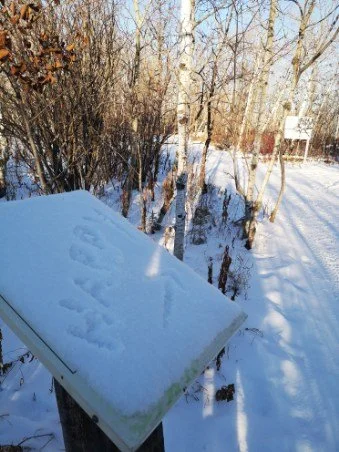Happy written in snow on a sign along a trail. (A.Luca)
We are all very familiar with the concept of snow. It can be beautiful and the basis of a number of winter activities. It can, however, fill our sidewalks and drive ways, clog up our roads and make walking and driving difficult. It can, in sufficient amounts, cause damage to trees, shrubs, buildings, power poles and bring a city or region to a standstill.
We call what we see falling from winter clouds snowflakes. What we see land on a surface is quite different from where and how it began its journey. What we call snowflakes are actually a collection of ice crystals. The ice crystal formed in the clouds some distance above the ground. Before any ice crystal can form a couple of conditions must be present in the atmosphere. There has to be water vapor and minute particles of matter. These particles can be any kind of solid matter including salt crystals.
To start the process water vapour must collect on the particle. The water vapor then turns directly into ice with no liquid water stage occurring. This transition from vapour to ice is just one of the many interesting things about the chemistry of water. Because of the shape of water molecules and the way that they join together the ice crystal takes the shape of a six sided prism.
The prism shape has six sides and a top and bottom surface. As the ice crystal is moved around by moving air it bumps into more water vapour that freezes onto it, thus increasing its size. The growth in size of the ice crystals occurs at each of the six points of the hexagonal prism. The process gives the ice crystal its characteristic six sided shape. The way a snow crystal grows is dependent on the temperature in the clouds and the amount of water vapor. In time the ice crystal is too heavy for the moving air to hold it up. It starts to fall toward the ground. Because there are so many ice crystals in the cloud and the air is moving, the ice crystals bump into each other. Depending on conditions, the ice crystals that collided with each other may stick together. At the point where ice crystals stick together we have the concept of a snow flake, because a snow flake is many ice crystals stuck together. So what we see falling from the clouds and call snowflakes is in reality a very large collection of ice crystal joined together. The actual shape of the snow flake that we see is dependent on what happens to it on the way to the ground. Atmospheric conditions such as air movement, moisture and air temperature have a significant effect on the final shape of the snow flake.
What Colour is Snow?
When we see snow falling or snow on the ground it is described as being white in colour. This observation is interesting because the ice crystals that make up the snow flake are clear. The answer lies in what happens to light when it hits the snow flakes. When an object reflects back all the wavelengths of the visible spectrum we have learned to call the colour of the object white. That is exactly what happens inside a snow flake. The light enters into the snow flake, bounces around from ice crystal to ice crystal and leaves the snow flake to be captured by our eyes. Because all the wave lengths that went into the snow flake come out, we record the colour as white. Sometimes if the light penetrates into the snow on the ground, some of the red wave lengths do not come back out and we may record the snow colour as being slightly blue. Our eyes are good at adapting to such things but if you take a photograph of the snow scene you will more than likely see a blue tinge in the picture.
Snow as Sound Absorber
Have you ever gone outside after a generous fall of fluffy snow and things seem unusually quiet. The reason is that the light snow on the ground has trapped a large amount of air in it. The sound energy strikes the snow but is not reflected back. The air pockets trapped in the snow act as sound absorbing chambers, thus the reduced sound levels.
Snow Noises
Have you ever noticed when walking or driving on snow that it makes a sound? When the air temperature is -10°C or lower the ice crystals that form the snow do not want to slide over each other as readily as they do at warmer temperatures. The ice crystals grind against each other or actually break making the distinctive crunch or squeak.
Snow as an Insulator
This may sound unusual because we know snow to be cold to the touch. In fact snow can act as an insulator in couple of important ways. As snow falls to the ground it traps a certain amount of air among the flakes. This trapped air prevents heat transfer just like the filling in your winter jacket. The more trapped air the better the insulation value. The longer the snow is on the ground the lower the insulation rate as the snow becomes more compact and thus has fewer air spaces. This snow insulation factor is important in that it affects how cold the ground gets and therefore has an effect on the degree to which the ground freezes. This can be a very important factor for animals that burrow into the soil and leaves to survive the winter. In a similar way the insulator property of snow is important to the mice and voles that do not hibernate and live in the space between the ground and the layer of the snow next to the ground. The space that they live in is called the Subnivian zone. It is created when some residual heat from the ground causes the snow to go straight to water vapour without the liquid stage (sound familiar). The water vapour wicks up into the snow and freezes. The iced layer forms the roof of the tunnels that these animals make in the snow. It does not take many centimetres of snow to keep the temperatures in the tunnels around or slightly above the freezing mark.
In more human terms we have used the insulating value of snow for a long time. An example of this is the igloo. Blocks of packed snow cut, shaped and stacked one upon the other to form a habitable shelter.
Part of a winter survival program may include the idea of using natural or making snow caves to get out of the elements on a temporary basis. Another example would be the making of a quinzee on a winter camping experience. We may or may not appreciate snow but it is a very significant factor in the natural world.








